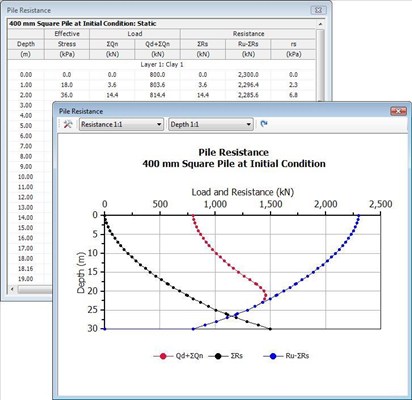Your single point of reference for all your Geotechnical Inquiries
UniPile 5.0
An application for the analysis of piles and pile groups according to various design methods. UniPile considers bearing capacity, pile group settlement, negative skin friction, and drag load. Aspects of drivability and residual stress are also included. It also simulates the load-movement behaviour of the pile in a static Head-Down and Bidirectional (O-Cell) loading test.
Pile ultimate resistance may be calculated using the Static (Beta or Alpha), Eslami & Fellenius (CPTu), Schmertmann & Nottingham (CPT), deRuiter & Beringen - Dutch (CPT), Bustamente - LCPC (CPT), Decourt (SPT), O'Neill-Reese (SPT), or the Meyerhof (SPT) methods.
Features and Advantages:
-Developed for Microsoft Windows 7 (32 and 64-bit), it is also compatible with Windows Vista and Windows XP SP3.
-Server side compatible and can be run within the limited privileges of Microsoft Windows standard user accounts.
-Unipile can combined up to 25 soil layers with the soil strength parameters, soil compressibility, as well as pore pressures varying within each layer.
-Perform calculations in either English or SI-units and convert from one to the other and back again with one simple keystroke.
-Analyze piles of all types and sizes; driven piles and drilled-shafts, single or in group.
-Analyze piles of all shapes; square, rectangular, hexagonal, octagonal, round, or H-section.
-Analyze tapered piles; step-tapered, uniform tapered, mono-tubes, and underreamed piles.
-Determine the effect of capacity variation between piles in a group.
-Analyze the settlement of a pile group and the surrounding area simultaneously using the conventional cc-e0 approach, the E-modulus, or the tangent modulus method for each individual soil layer.
-Determine the distribution of residual load and how it would affect measured loads.
-Simulate a Head-Down and Bidirectional (O-Cell) static loading test with input of t-z curves for each separate soil layer. The simulation uses the calculated shaft and toe capacities and is useful when calibrating the analysis to the results of a static loading test and when designing for deformations under the pile loads.
-Produce the capacity and distribution of shaft and toe resistances in a table format compatible with the GRLWEAP input at both initial driving and at restriking. At both initial installation and after set-up.
-All results are presented in tabular and graphical form. These can be exported to Excel format or Tab-delimited text format for further manipulation and reporting.















